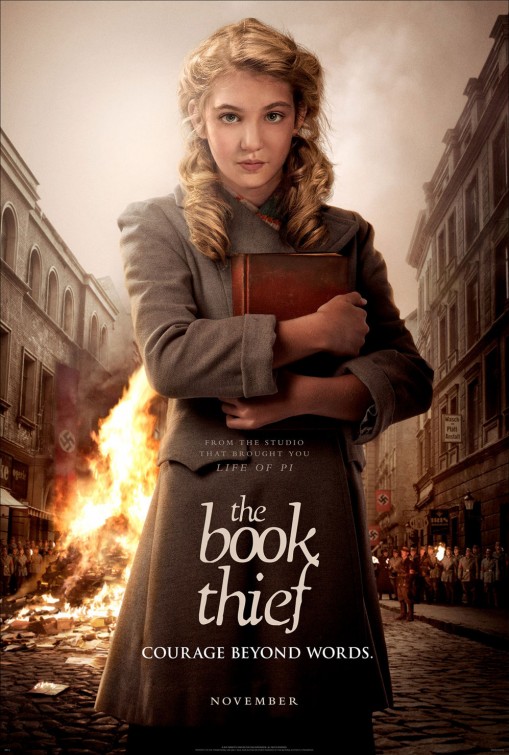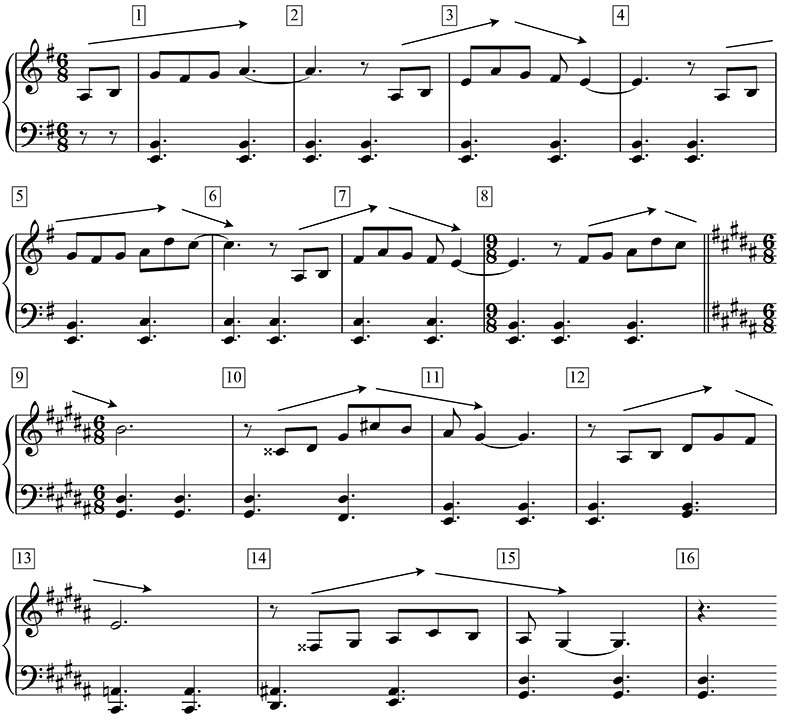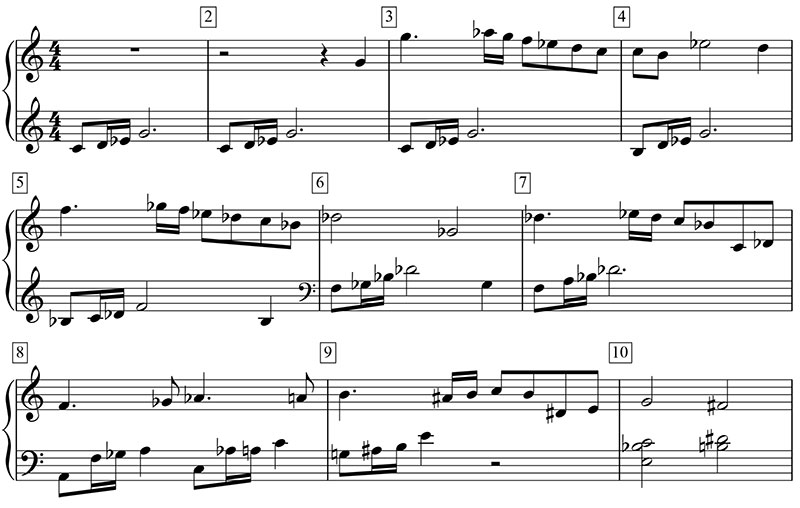
With his score for The Book Thief, John Williams earned his 49th Oscar nomination, adding to his impressive achievement as the second most Oscar-nominated individual in history behind only Walt Disney, who earned 59 nominations. As with so many of his other scores, Williams constructs a large portion of his score for The Book Thief by stating and varying a handful of musical themes. The following film music analysis will provide a brief overview of the score’s style, then examine how Williams adapts several of his themes to various dramatic situations through the process of thematic transformation.
The Style of the Score
The Book Thief being a tale of the struggle for survival under Nazi rule during the Second World War, one might expect to hear echoes of Williams’ score for Schindler’s List throughout the film. But his music for The Book Thief actually bears the strongest resemblances to his score for the 1999 film, Angela’s Ashes, likely because both films present stories of life’s hardships largely from the innocence of a child’s perspective. Hence, there is a bittersweet quality to both scores that is reflected in Williams’ prominent use of lyrical themes in minor keys. The similarity between the two scores is most evident in their main themes. Here is that of Angela’s Ashes:
Now compare this to the main theme of The Book Thief:
The instrumentation for the two films is also quite similar, as both rely heavily on solos provided by the piano, oboe, and harp, and commonly draw on a full-bodied string sound for contrast. (Compare, for instance, the solo piano opening of each clip above.) In addition, both scores make use of playful, scherzo-like cues written mainly for strings for more lighthearted scenes. The two scores, however, differ in their details and the way in which Williams varies the themes to suit the unfolding drama. I explore three of the most prominent themes in the film below.
Liesel’s Theme (The Main Theme)
The above main theme of The Book Thief is associated with the main character, Liesel, a young adolescent girl whose mother, fearing for her life as a Communist in Nazi Germany, takes Liesel to live with foster parents Hans and Rosa at the start of the film. En route, Liesel witnesses the death and burial of her younger brother. Thus, Liesel’s circumstances are not only emotionally difficult, but constantly dangerous as well. In addition to the bittersweet sound of the theme’s minor-mode lyricism, Williams infuses Liesel’s Theme with a sense of struggle through its musical intervals. Here is the full version of theme:

The theme divides into two eight-bar halves: the first half is the one we hear most often in the score, the second half acting as a kind of varied repetition of the first half. My analysis shows the contours of the melody with arrows above the staff.
Of note here is the way Williams shapes each two-bar phrase of the melody. In the analysis, notice that the first phrase is the only one that has an overall rising contour after an upward leap. After that, every phrase takes a downward turn following its initial rise. More than that, each descent is stepwise, suggesting a gradual fall from an initial burst of energy. In human terms, this technique suggests a negative force that is weighing down on the hopes of the protagonist, which is a fitting expression of Liesel’s constant emotional struggle of having those she most cares about whisked away by both the Nazis and the war.
The second half of the theme is even more pessimistic in a number of ways. First, it is jolted into a distantly-related minor key (much as Liesel must constantly adjust to jarring new situations). Second, now every phrase of the melody including the first is dragged down in steps at its end. And third, the chord in bar 13 that prepares for the final phrase is what is called the “Neapolitan” (or flat II) chord, which lowers the second degree of the scale and creates a more melancholic sound (as flattened notes tend to do). All of these musical features serve to reinforce, indeed enhance, the emotional content of the theme’s first half.
Variations of Liesel’s Theme
Williams subjects Liesel’s Theme to several variations according to the narrative situation. When Liesel first goes to the house of the Bürgermesiter (the mayor), she is apprehensive about entering his property, no doubt due to the Bürgermeister’s strong affiliation with “the Führer” and Liesel’s Communist background (about which there are rumours). The statement we hear of Liesel’s Theme here is accordingly hesitant, with the piano sounding its first three notes and pausing before playing the next three notes of the phrase. After a short orchestral comment from the strings, the same phrase is then restated in varied form but with the same hesitant qualities. Hear these in the track below:
At other times, Williams uses only the four-note “tail” of the theme’s second and fourth phrases. When Liesel and Rosa say goodbye to Hans at a train station, as he has been conscripted into the German army, we hear the four-note tail clearly twice at the beginning, at 0:29, 1:03, 1:13, 1:28 (extended to eight notes), and repeatedly from 1:44:
The use of this tail as the basic material for the cue could be understood as a reflection of the Nazi’s overwhelmingly negative effect on Liesel during this scene. And yet the cue’s lyricism still manages to express much of the love she and Hans feel for one another.
Death’s Theme
As both a concept and a character, death plays an important role in The Book Thief. Most prominently, Death narrates the film as a disembodied voice. Williams therefore writes a theme for the character that returns several times:

The theme is scored for solo piano, which emphasizes the loneliness one feels in having lost a loved one. Harmonically, the theme is built largely on the sorrowful sound of minor chords, but always with an extra semitone added to the chord, which adds a sense of pain through its biting dissonance. The theme also drifts from C minor through Bb minor to E minor, giving it a wandering and unpredictable character, much like Death itself. Notice as well the melody’s stepwise descents, which, like Liesel’s Theme, suggest a heavy emotional weight, now of grieving the death of a close relation.
This theme is heard at the opening of the film, as Death begins the narration, and returns shortly afterward at the funeral for Liesel’s brother. But a couple of other cues introduce some appropriate variations. When the German town in which Liesel and her family live is bombed, for example, Death’s narration enters again, but the theme is now unharmonized and scored entirely for solo oboe, adding a sharp poignancy to the scene of destruction that is about to play out. Hear this in the track below:
In the film’s final scene, we see the inside of the New York apartment of the adult Liesel, presumably after her death. As Death narrates how she lived out the rest of her life, we glean that Liesel became a successful writer as the camera pans across a few small stacks of her novels while Death comments that “her stories had touched many souls.” As this scene begins, we hear Death’s Theme, still played softly on the piano, but now transformed into a major key. This subtle change allows the theme to take on a positive connotation, in the same way that Liesel took her wartime experiences with death and turned them into stories that “had touched many souls,” ending the film on a more optimistic note. Hear this below:
Max and Liesel’s Theme
After the war breaks out, a young Jewish man named Max comes to Hans and Rosa in flight from the Nazis. As Max’s father saved Hans’ life in World War I, Hans and Rosa agree to keep Max in hiding at their home. Liesel, who has been learning how to read from Hans, forms a friendship with Max (as a sort of brother she no longer had) through her skills of reading and writing. Max, for instance, gives Liesel a journal at Christmas, and Liesel reads books aloud for Max when he is seriously ill.
We hear the theme when Max decides it too dangerous to continue to stay with Hans and Rosa after a neighbourhood shopkeeper’s Jewish roots are discovered and he is taken away. As Max is explaining to Liesel why he must leave, we hear the following form of the theme:

Once again, this theme is set in a minor key, now to express the heartbreak Liesel feels at Max’s departure. Notice how the bass line takes up the four-note tail from Liesel’s theme, not only suggesting the same negative effect of the war on Liesel, but also subtly expressing how close-knit the two characters have become.
We also hear the theme when Liesel learns that Max has recovered from his illness and will live on. As she rushes home to see Max again, the theme is clearly in a major key to reflect Liesel’s joy in hearing the good news. But notice that the four-note tail is absent from this version, aptly reflecting the small victory in overcoming the Nazi’s oppressive force:
After the war, when Liesel sees Max again after fearing him dead, we hear the theme once more, now more similar to its form when Max departs, but with an important alteration. This time, Williams changes the opening bar to start on a major chord (this is clear on the second chord we hear, when a dissonance in the bass resolves) while the rest of the theme remains largely as it was. This harmonic change reorients the theme so that we now hear the theme as emerging from a major rather than a minor key. In technical terms, Williams converts the theme so we hear it as beginning in the relative major of the original minor key. The four-note tail is gone as well, all of which suggests the positive new beginning to the old relationship Liesel and Max began under more negative circumstances. Listen to this version below:
Conclusion
With his score for The Book Thief, John Williams continues to demonstrate his talent for thematic invention and transformation. And as with his other scores, he manages to write music that is highly tailored to the emotional nuances in a given scene. With consistency like this, it is no wonder he has earned so many Oscar nominations over his career.
Coming soon… Thomas Newman’s Saving Mr. Banks.
This is excellent food for the brain!! I didn’t know the “Angela’s Ashes” music before and its major-minor tonalities provides a better melody, IMO, than “The Book Thief” from the excerpts you’ve posted here.
Your first musical example: I was intrigued by the 6/8 time signature. Presumably the opening motif is in G Major and then it shifts to G# Minor? That is a remote relationship and I was intrigued by the ‘false relations’ in bars 10 and 14!! Interesting composing. Obviously a substantial composer, but I doubt the Academy or international press corps would be discerning like yourself!! In the first excerpt from “The Book Thief” I could also hear the influence of Michel Legrand (Thomas Crown Affair)!! That rippling piano ostinato!! And, in the orchestral support, some hints of Philip Glass. (I speak here of “Angela’s Ashes”.) In short, a much more interesting piece. I’ll listen to the rest when my internet speed is adequate, then return with comments.
absolutely gorgeous score by John Williams. Pray tell, who is the amazingly wonderful oboe player on the main theme? Being an oboe player myself, it is hard work it sound this beautiful on such a monster of an instrument! Thanks for the info!
According to the liner notes, the principal oboe is played by Jessica Pearlman, so she would be the one on the solos. (The 2nd oboe is played by Lara Wickes.)
Can you find how to create a web with Leitmotifs and some analysis on Ravel Daphnis et Chloe